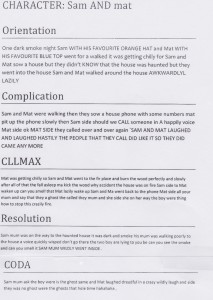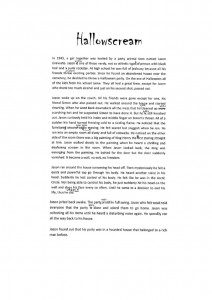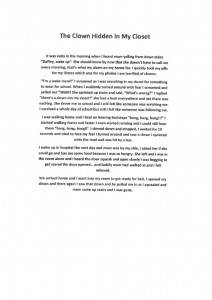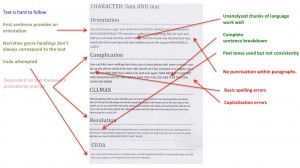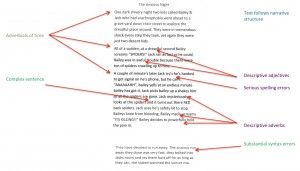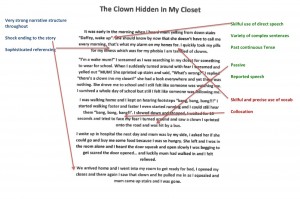16. A ghost story
Please click on the toggles below to navigate through information on this assessment task and reveal the links for downloading task materials.
Task details |
|
| Name of writing assessment task | A ghost story |
| EAL curriculum level range | B2, B3, C2, C3, C4 |
| Text orientation | Imaginative |
| Task type | Cued response/extended response |
Task specification |
|
| Purpose | To assess students' ability to write a narrative based on given pictures. |
| Description | Students are given a sequence of pictures which tell a ghost story. Students write the story independently. |
| Assumed knowledge and description |
4. Vocabulary:
|
Learning/teaching context |
|
| Language centre/mainstream class | EAL support/mainstream class |
| Subject/key curriculum objectives, outcomes | English |
| Topic/teaching unit | Stories |
| Assessment conditions |
|
| Notes |
|
Task implementation |
|
| STAGE | ACTION STEPS |
| Pre-assessment activity |
|
| Assessment activity |
|
| Post-assessment activity |
|
- TEAL Writing Task 16 – unmarked criteria sheet [PDF]
- TEAL Writing Task 16 – unmarked criteria sheet [Word]
An explanation of the purpose, nature and use of criteria sheets is available at 4. Using the assessment criteria.
Purpose and value of the task
The task requires students to produce a narrative text around the theme of ghost stories. As ghost stories are universal the task provides an accessible way for the EAL students to learn the basic structure of narrative texts. The task allows teachers to see how students are developing skills in relation to a written narrative, through their personal response to a common theme that allows the students to use their imagination in producing a response. This task is related to TEAL Writing Task 5: Story retell, TEAL Oral Task 3: Story Retell, and TEAL Oral Task 12: Retelling a folk story or legend.
Contextual information
The EAL students who produced these samples were in a mainstream Year 7 English class. The modelling and development of the students’ writing took place over a series of lessons. The teacher modelled the narrative structure orientation, complication, climax, resolution and coda using a storyboard with comic format, with the software Comic life. The teacher differentiated the work for the EAL students during the support process and gave them and a few others the ghost story topic as it was more accessible. Lists of adjectives and adverbs were provided and students practised using descriptive language. They edited their first drafts before submitting the drafts analysed here as samples.
Commentary
The samples range from one that is heavily dependent on a handout of the text structure to more fluent examples of ghost story narratives. They attempt to develop a sense of suspense, with varying degrees of success, as evident in some attempts to use innovative, but sometimes unsuccessful, combinations of words. They all have an imaginative quality, but some are more adept at the genre and so a more convincing. All the samples are comprehensible, but they include some noticeable errors of grammatical structures and vocabulary. While the samples are second drafts completed on a computer, there are still errors of formatting and print conventions.
Year: 7
Commentary
The text essentially follows a narrative structure, though not matching the headings the student uses. At times, poor coherence makes it hard to see where the story is going. The layout is disruptive to the reader, that is, using misleading and unnecessary genre headings, changing font sizes and capitalisation.
Vocabulary is barely adequate. Terms like dark smoky night, getting chilly, wisped (whispered) and crazy wildly laugh support the ghost story but some words don’t work, for example, laughed hastily. Poor word forms such as went for a walked and spelling such as side for said are also very distracting.
Some grammatical features are used, though inconsistently, for instance, past tense went, laughed. Occasional unanalysed chunks work well such as but they didn’t know that the house was haunted but correct sentences are rare. Punctuation is almost non existent.
Some cohesive devices are used well, for instance, occasional pronoun reference and conjunctions such as Mat was getting chilly so Sam and Mat went to the fir place. But a key weakness of the text is that coherence is quite often poor. Sentence breakdowns occur regularly due to limited vocabulary and syntax: SAM AND MAT LAUGHED AND LAUGHED HASTILY THE PEOPLE THAT THEY CALL DID LIKE IT SO THEY DID CAME ANY MORE
The marked criteria sheet shows how the student meets most criteria at level 1 of performance.
The student’s language use in this task is consistent with the descriptions at Level C2, .
Using this assessment for further learning
- Pronoun reference
In the sentences below, draw a line from the underlined word to the word it belongs to. The first one is done for you.
• One day a young boy saw a beautiful new bicycle.
• It was a beautiful bicycle with blue wheels. When he saw the bicycle lying on the ground he decided to ride it home.
• When a polar bear saw a seal standing on the ice, it tried to catch it but the seal was too quick and dived through a hole in the ice. It was a small hole so the bear couldn’t get through it and so it didn’t have any dinner to feed its baby bear cubs
- Punctuation
• Read the student’s first paragraph to them with suitable pauses for commas and full stops. Ask them to put in the commas and full stops based on the reading. Ask them to read the paragraph in the same way themselves.
One dark smokey night Sam with his favourite orange hat and Mat with his favourite blue top went for a walked it was getting chilly and Sam and Mat sow a house but they didn’t know that the house was haunted they went into the house Sam and Mat walked around the house. Awarkwardly and lazily
• If time permits repeat for the other paragraphs but ignoring sentences that are incomprehensible.
• Ask the student to review their text and insert full stops where needed.
3. Coherence
• Ask the student to retell the story orally (to the teacher or aide) without worrying about description or the narrative stages.
• Where meaning is unclear, ask the student to clarify and, where necessary, recast the student’s sentences but with a focus on communication over accuracy.
• Correct their original written draft by providing some relevant vocab and correcting a few key errors but focusing on communication rather than accuracy.
• Point out areas in the text that are especially confusing.
• Ask student to rewrite the story without worrying about description, making sure that the reader can understand what happens. They may need to add more information to make the story clearer. Ask them to show the second draft to a fellow student to see if any parts are hard to understand and revise their work accordingly.
Year: 7
Commentary
The story follows the structure of narrative with mixed success especially in the final paragraph which does not link to the rest of the story. Some vocab is used effectively, for example, safety kit explore, spiders crawling. There is also a good attempt to use descriptive language such as dreadful second, endless minute but often this becomes awkward, such as in tremendous shock every step, mysteriously looks at the spiders.
The writer uses a range of grammatical features successfully, for instance, complex sentences – uses his safety kit to stop Bailey’s knee from bleeding, there were (a) ton of spiders crawling up to him modality as fast as he could, and the use of past tense. But there are also many errors for example using done for did and regularly using the present tense for the past. A significant weakness is basic spelling errors: he’s for his and try’s for tries and there for they’re.
Cohesion is handled quite well with pronoun reference and linking between paragraphs using time markers: one dark night, all of a sudden, a couple of minutes later.
The marked criteria sheet shows how the student meets most criteria at level 2 of performance.
The student’s language use in this task is consistent with the descriptions at Level C2, Victorian Curriculum F-10 EAL.
Using this assessment for further learning
1. When and when not to use apostrophes
Ask the student to look at this sentence from the essay. Point out there is something wrong with each word marked with an asterisk. Ask the student to use the table to make corrections. (Students could work in pairs to do this.)
A couple of minute's* later, Jack try's* he's* hardest to get a signal on he's* phone, but he can't.
| Use of an apostrophe | Yes | No |
|
Plurals: e.g. seats houses chairs minutes |
No | |
|
Third person singular verbs e.g. she runs he calls she says he tries |
No | |
|
Contractions (shortening) of two words into one e.g. she is = she's he is = he's they are = they're is not = isn't can not = can't will not = won't |
Yes | |
|
Personal pronouns of possession/ownership e.g. The pen is his That is hers These are ours That is theirs |
No | |
|
Ownership or possession with a name, or noun e.g. Mary's house John's pen Mehmet's sister The dog's tail |
Yes | |
|
Ownership or possession with a personal pronoun e.g. her house his sister her pen his phone their family |
No |
Now ask the student to check the rest of the story for similar errors.
If necessary, check the student is familiar with the spelling rule that when a verb ends with 'y' e.g. cry, try, fly, when 's' is added to make the third person singular the 'y' changes to 'ie' e.g cries, tries, flies.
2. Pronouns
Revise the pronouns from the table below. Point out especially *he’s (he is) *his, and * they’re * their so they can see them in relation to the other pronouns.
| I I am a student. | Me Give it to me | My My shoes are dirty |
|
you You are a boy. You are good students |
you I know you. | Your Your hair is wet. |
| he/she He is *(he’s) is a boy. She is *(she’s) a girl. |
him/her Tell her. I saw him |
*his/her His eyes are brown. Her eyes are blue. |
| we We live. | us They know us | Our Our father is a fisherman. |
| they They are *(they’re) from Iran. | them Give them some money | *their Their sister lives in Iran. |
Use the correct pronoun from the table above in the exercises below. The first one is done as an example.
a) One day a little girl called Emilia was lonely so ……she……. called …………friend Lee to come and play with …………….
b) Jim is a Year 10 student. …………. family live next door to my house. Jim’s family and ………………. family are all friends. so ……………….. often have dinner together. When ………………… eat together everyone agrees ………………… favourite food is chicken. Jim hates doing schoolwork and one day ………………. father told ………………….. to study harder or ………………. would have to leave school. Jim told ………………… father that ……………… wants to get a job. I am worried about …………………. as …………. is not easy to find a job.
- There, they’re, their
Discuss and practise the three examples below noting how all are said in the same way.
There are seven children in the Chin family.
They’re (They are) a big family.
Their uncle lives in Canada.
Use the correct form there/they’re/their in the spaces below. The first one is done as an example.
Two sisters are studying in Melbourne. …their….. parents live in India so the girls live with ………………. grandmother who has a large house in Melbourne. ……………are five bedrooms in the house and ……..……is a large lounge room.. The girls like the beach but ………………… afraid of sharks. …………………. also afraid of sunburn under Australia’s hot sun even though ………………… skin is already quite dark as …………………… from the south of India.
Year: 7
Commentary
The text follows the basic narrative structure though the coda is tokenistic and unsatisfying. A strength of the text is a wide range of topic vocabulary that help set the mood for a horror story: abandoned, dusty, cobwebs, vanished, haunted, and effective collocations such as passed out, bolted for the door, throw a party...
The writing shows good control of complex sentences, for example, he noticed there was a big painting and passive e.g. was hosted. Narrative tenses past and past continuous are mostly used well but sometimes misused: furniture (was) oddly moving, slaps (slapped) his face, but the past perfect was not used where needed, such as his friend Simon who (had) passed out, suspected Simon to have (had) done it.
Cohesion is mostly handled effectively through paragraphs, through time markers: then, all of a sudden, on the eve and reference except for one.
The marked criteria sheet shows how the student meets most criteria at level 3 of performance.
The student’s language use in this task is consistent with the descriptions at Level C3, Victorian Curriculum F-10 EAL.
Using this assessment for further learning
- The past perfect
The student is ready for an introduction to the past perfect as they needed to use it three times but weren’t able to.
- First point out how the past perfect is made: had + past participle and then when it is used – when it is useful or necessary to show that one event in the past happened before another.
- Ask student(s) to look at these examples from the text:
- All his friends were gone except for his friend who passed out.
- When he went back downstairs all the mess he cleaned up was now scorching hot.
- He suspected his friend Simon to have done it
- In the first sentence, ask the student to underline which of the two events in bold happened earlier. It’s helpful to show that Simon passed out some time before his friends left so the past perfect tense is used – had passed out.
- The student completes the same exercise for the other sentences. (Note that the third sentence is arguably not incorrect but is awkward and complicated.)
2. Coda
Discuss the intention of the coda – to help explain the events that happened in the house and give the reader a resolution.
- Point out how the coda is too brief and so leaves the reader unsatisfied.
- Ask the student to rewrite the final paragraph to give a more interesting and satisfying conclusion. For example, what had happened in the haunted house before? Is there a violent history to the house that linked it or its owner to the King?
Year: 7
Commentary
The student has achieved the text’s purpose to scare and entertain very successfully through a clear story line and sophisticated narrative structure. The opening paragraph quickly orientates the reader, the complication (the clown) reappears throughout the story and the resolution is suitably disturbing.
The reader is drawn into the story through a skilful use of direct speech, through a description of feelings felt scared, relieved, terrified, and through use of the past continuous for suspense felt someone was following me. The writing is fluent due to the writer’s control of a range of grammatical features such as complex sentences I still felt like someone was watching me, reported speech I asked if she could go …. and passive hit by a bus. Precise use of vocab also helps fluency and coherence e.g. collocations face my fear, door squeak.
Cohesion is well managed, for instance, through reference ’that’s what my alarm is for’ and effective linking between paragraphs except for Paragraph 3 beginning I was walking home…. The narrative could be strengthened by an occasional change of pace to create suspense, for example, in the last line.
The marked criteria sheet shows how the student meets most criteria at level 4 of performance.
The student’s language use in this task is consistent with the descriptions of students at Level C4, Victorian Curriculum F-10 EAL.
Using this assessment for further learning
1. Change of pace
- The story line for this text is very strong with some suspenseful moments. Point out how, at times, a writer can speed up and slow down the narrative to create maximum effect.
- Ask student(s) to look at the climax in the final paragraph and reflect where suspense could be increased by slowing down the action. An example would be adding some details just before opening the closet: sat on the bed, wrote a few lines in my diary. Another time to create suspense in this way might be when the mother ascends the stairs.
- Look at Paragraphs 2 and 3. Could a change of pace be applied effectively here?
2. Coda
- Discuss whether the story is best left with the short sharp ending (valid option) or whether a follow up coda might add interest.
- Discuss possible roles of a coda, for example, to reflect on what has happened, to link the story to the future, to add a moral lesson, to provide an explanation, to reinforce the mystery.
- What could a coda add to this story? One example might be added intrigue to leave the reader pondering such as the police are called, but no trace is found. She is never seen again.
3. Linking between paragraphs
Ask the student to read the whole text and comment on the links between paragraphs. If necessary point out how a time marker is needed between Paragraphs 2 and 3 e.g. That afternoon …

